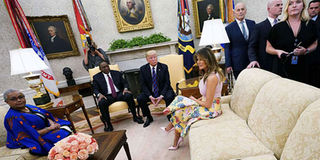MSHINDI: US bilateral trade terms call for very delicate balancing

From left: Kenyan First Lady Margaret Kenyatta, President Uhuru Kenyatta, US President Donald Trump and US First Lady Melania Trump hold a meeting at the White House, Washington, DC, on August 27, 2018. PHOTO | JOAN PERERUAN | NATION MEDIA GROUP
What you need to know:
- The prohibitive cost of energy, bureaucratic delays hindering policy reforms, tax disincentives and lack of a local content policy are just some of the notable ones.
- However, none is more scary than entrenched corruption that sucks life out of any progressive policy and chases away investors.
- Any deal that opens up the country without sealing the many loopholes that limit the capacity of local industry to compete globally will be yet again, a horrendous betrayal of Kenyans cheated by leaders they expect should protect them!
The terms the US has set out as its wish list before it can finalise a “model” free-trade agreement with Kenya read like a very bad proposition and the country must be very careful how it manages the ongoing talks.
The US, which is seeking to replace “unfair” agreements like the Africa Growth and Opportunity Act (AGOA) with free trade deals, wants its firms to enjoy unfettered entry into nearly all segments of Kenya’s economy. It is pushing to have its agricultural products allowed in at zero or reduced tax, and wishes smooth entry into telecommunications services. This is not all.
The 2015 Trade Promotion Authority (TPA) law, under which the Trump administration seeks to conduct the free trade agreement, signals that the US is not seeking a “mini-deal” or a phased negotiation.
“TPA includes a long list of objectives Congress has mandated the administration to pursue,” says a March 2020 paper by the Centre of Strategic and International Studies.
At the second US-Kenya Trade and Investment Working Group meeting in November last year, the delegates discussed possibilities in “services, digital trade, intellectual property, agriculture, environment, customs and trade facilitation, technical barriers to trade, labour and state-owned enterprises.”
The US has its reasons for seeking a free trade pact with Kenya (the second African country after Morocco) at the top of which are strategic interests – check China’s influence in Africa and bolster its anti-terror security ties with Kenya. It would be a useful bonus too if it can perfect a replicable model to replace the multi-country AGOA, which runs its course in 2025.
Kenya is obviously keen to protect the modest but relatively significant free market entry gains that the trade agreement has given its products. It is keen that access to the US market is not curtailed if the agreement lapses without a replacement deal. The country also hopes to diversify its trading options by deepening its market links with the US.
But significant hurdles stand in its way. First, its commitments to the regional block trade protocols restricts its freedom to sign off on unilateral trade deals. It must therefore be prepared to delicately handle the inevitable push back from the East African Community and the African Continental Free Trade Agreement (AfCFTA) that comes into effect on July 1.
Internally, the plan will open up the country to more imports that will further threaten the fragile manufacturing base. That would be a double blow because having free access to the US market does not mean the opportunity will spur growth here.
Only Kenya’s textile and apparel industry has been able to tap into the AGOA window and only to a limited extent, given that the US apparel market is worth $368 billion, with one retailer moving $20 billion worth of apparel in 2019. Kenya’s apparel exports under AGOA were less than $500 million.
Opportunities exist for the East African region, and Kenya specifically, to emerge as a favourite potential apparel sourcing alternative to the traditional source markets of China, India, Sri Lanka and other Asian countries. But plenty of work must be done at the policy level to spur local manufacturing capacity before it can produce goods that can compete globally on quality, price and increasingly, on environmental sustainability.
The prohibitive cost of energy, bureaucratic delays hindering policy reforms, tax disincentives and lack of a local content policy are just some of the notable ones. However, none is more scary than entrenched corruption that sucks life out of any progressive policy and chases away investors.
Any deal that opens up the country without sealing the many loopholes that limit the capacity of local industry to compete globally will be yet again, a horrendous betrayal of Kenyans cheated by leaders they expect should protect them!
Tom Mshindi is a former Chief Editor of the Nation Media Group and is now Managing Partner at Blue Crane Global consulting. [email protected], @tmshindi





